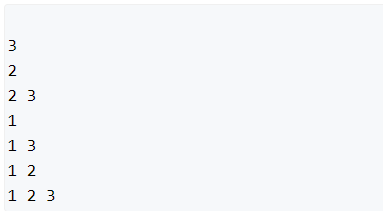

方法一:二进制状态枚举
1 #include <bits/stdc++.h> 2 using namespace std; 3 const int N = 20; 4 int n; 5 int main() { 6 cin >> n; 7 for (int i = 0; i < (1 << n); i++) { //枚举所有状态 8 for (int j = 0; j < n; j++) { //枚举每一位 9 if (i >> j & 1) { //如果该位是1,表示选择 10 cout << j + 1 << " "; 11 } 12 } 13 cout << endl; 14 } 15 return 0; 16 }
方法二:dfs
1 #include <bits/stdc++.h> 2 using namespace std; 3 int n; 4 int st[20]; //标记每一个数有没有被选,0表示还没考虑,1表示选,2表示不选 5 void dfs(int u) { //判断u这个数要不要选 6 if (u == n + 1) { //如果n个数都已经判断完了 7 for (int i = 1; i <= n; i++) { //遍历n个数 8 if (st[i] == 1) { //如果该点选择了 9 cout << i << " "; //输出该点 10 } 11 } 12 cout << endl; 13 return; 14 } 15 //不选u这个数 16 st[u] = 2; 17 dfs(u + 1); 18 st[u] = 0; //回溯恢复现场 19 //选u这个数 20 st[u] = 1; 21 dfs(u + 1); 22 st[u] = 0; //回溯恢复现场 23 } 24 int main() { 25 cin >> n; 26 dfs(1); //从数1开始搜索,判断其要不要选择 27 return 0; 28 }
方法三:递归,其实递归和dfs本质上是相同的,不过也是另外一种思路
1 #include <bits/stdc++.h> 2 using namespace std; 3 vector<int> chosen; 4 int n; 5 void calc(int x) { 6 if (x == n + 1) { 7 for (int i = 0; i < chosen.size(); i++) { 8 cout << chosen[i] << " "; 9 } 10 cout << endl; 11 return; 12 } 13 //不选x这个数 14 calc(x + 1); 15 //选x这个数 16 chosen.push_back(x); 17 calc(x + 1); 18 chosen.pop_back(); //回溯还原现场 19 } 20 int main() { 21 cin >> n; 22 calc(1); 23 return 0; 24 }